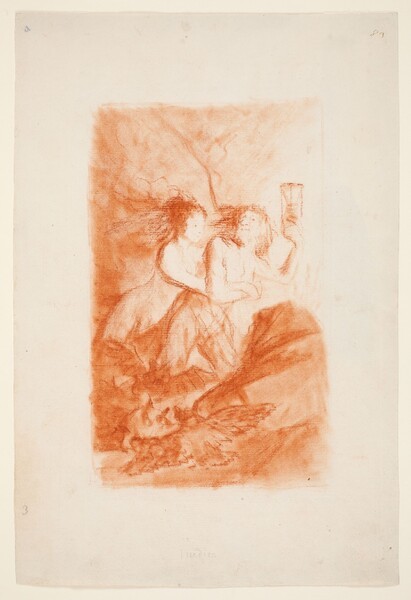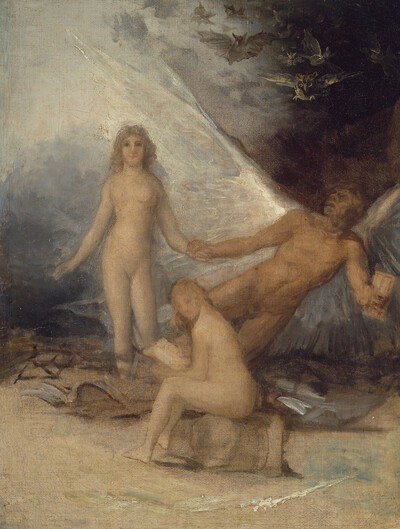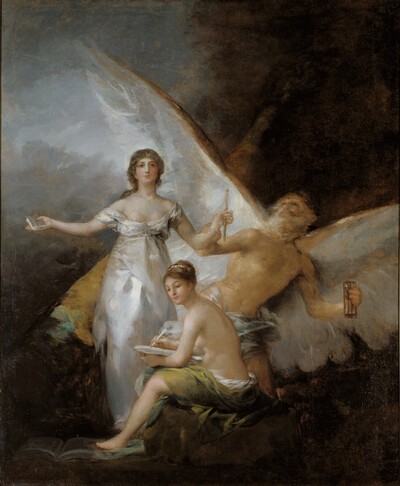- Cronología
- Ca. 1797
- Ubicación
- The Prado National Museum. Madrid, Madrid, Spain
- Dimensiones
- 305 x 207 mm
- Técnica y soporte
- Reconocimiento de la autoría de Goya
- Undisputed work
- Titular
- El Prado National Museum
- Ficha: realización/revisión
- 18 Aug 2021 / 28 Apr 2023
- Inventario
- Inv. 4338r
9 (in pencil, recto, upper left-hand corner)
83 (in pencil, brown ink, recto, upper right-hand corner)
3 (in composite pencil, recto, lower left-hand corner)
Unedited (in composite pencil, recto, lower centre)
[Stamp of the Museo del Prado] (stamp in violet ink, reverse, lower right-hand corner)
Watermark: [Large shield with helmet and letters "[H] C W" inside].
The piece is one of a series of drawings which, from their form and content, were undoubtedly made by Goya in preparation for the Caprices.
The drawing passed by inheritance in 1828 to Javier Goya, the painter's son, and in 1854 to Mariano Goya y Goicoechea, the artist's grandson. It was subsequently owned by Valentín Carderera (ca. 1861) and Mariano Carderera (ca. 1880). In 1886 it was acquired from Mariano Carderera by the General Direction of Public Instruction and was assigned to the Prado Museum, where it entered on 12 November 1886.
On the same sheet of paper there are two drawings. This one is on the recto or recto, while the reverse is occupied by The Truth. Sketch of a nude woman.
This drawing has been cautiously entitled Truth Rescued by Time and also Time and Truth, as it shows the figure of a nude woman clinging to the body of a winged man, also nude, carrying an hourglass. Both appear to be flying happily. Next to them fly some owls, animals very often depicted by Goya in this period of his career and directly related to The Caprices.
The identification of the male figure with Cronos has led many authors to relate this drawing to the large-format painting Truth, Time and History in the Nationalmuseum in Stockholm, a work by Goya of around 1812 in which the allegory of Time again appears in the same pose, with a girl who is not naked and who could be Philosophy or the incarnation of the Constitution of 1812. Above all, however, the drawing has been realted to a kind of previous, much earlier sketch (ca. 1797-1799) of that composition, also entitled Truth, Time and History (sketch) now in the Museum of Fine Arts of Boston, in which the young woman again appears nude and we find bats and owls flying in the night.
-
Goyas Spanien, Tiden och HistorienNationalmuseumStockholm1980
-
Goya. Das Zeitalter der Revolucionen. Kunst um 1800 (1980 – 1981)Hamburger KunsthalleHamburg1980cat. 102
-
Goya y la Constitución de 1812Museo Municipal de MadridMadrid1982organized by Madrid Town Hall, consultant editor José Manuel Pita Andrade. From December 1982 to January 1983cat. 5
-
El cuaderno italiano (1770-1786). Los orígenes del arteMuseo Nacional del PradoMadrid1994exhibited also at Palacio Revillagigedo, Gijón, Summer 1994, consultant editors Manuela B. Mena Marqués and Jesús Urrea Fernández. From March 2nd to April 30th 1994
-
Los dibujos de Goya, 2 vols.MadridAmigos del Museo del Prado1954vol. II, cat. 451
-
Goya, Saturno y melancolía. Consideraciones sobre el arte de GoyaStockholmAlquimis & Wiksell1962pp. 127-140 (il. 56)
-
Vie et ouvre de Francisco de GoyaParísOffice du livre1970pp. 164, 187, cat. 642
-
Dibujos de Goya, 2 volsBarcelonaNoguer1975p. 44, cat. 16
-
El mundo de Goya en sus dibujosMadridUrbión1979p. 4
-
Goya, Das Zeitalter de Revolutionen. 1789-1830HamburgPrestel-Verlag Münche und Hamburger Kunsthalle1980p. 150
-
ZaragozaCaja de Ahorros de Zaragoza, Aragón y Rioja1980-1982p. 114
-
MadridAyuntamiento de Madrid1982pp. 90-91
-
MadridMuseo Nacional del Prado1993pp. 222-225 (il. 156)
-
StockholmNationalmuseum Stockholm2001pp. 54-59, cat. 6
-
MadridFundación Lázaro Galdiano2010pp. 320-339, espec. p. 336



